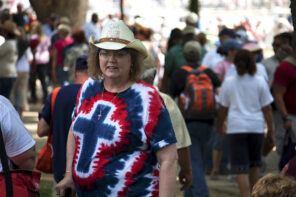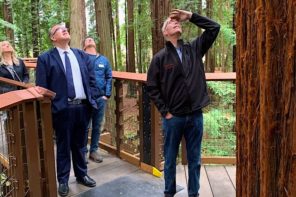Religion writers, both journalists and scholars, have had much to say of late about the continued growth of the religiously unaffiliated—especially given the impact of so-called “Nones” in the recent presidential election.
But much of what’s been written fails to highlight finer distinctions among Nones. So how to better understand this fast-approaching tipping point in American religion and spirituality?
Projects like progressive mainline Protestant Diana Butler Bass’ thoughtful, if sometimes historically strained Christianity After Religion and conservative evangelical David Kinnaman’s demographically interesting if theologically thin You Lost Me have attempted to understand how the Christian churches from which the majority of Nones emerge can attract and retain disidentified and disaffected believers.
But for those less interested in figuring out what’s wrong with churches and more keen to explore what Nones are up to on their own terms, the books below are a helpful start:
Catherine Albanese, A Republic of Mind and Spirit: A Cultural History of American Metaphysical Religion (New Haven: Yale University Press, 2006).
Albanese reminds readers that contemporary spirituality isn’t always, or even often, comprised of newly-minted, idiosyncratic practices. Her historical look at the metaphysical tradition from fifteenth century Europe to late modern America shows that while religious change in the United States has unfolded outside the normative boundaries of denominational Christianity, “new” developments in religiosity have hardly been random, disorganized experiments of the unfettered spirit.
The “historiography of connection” for which Albanese calls places spiritual and religious practice in the context of popular culture and political change, offering valuable insight into the current fascination with the religiously unaffiliated, changes in religiosity, and the evolution of American secularity.
Courtney Bender, The New Metaphysicals: Spirituality and the American Religious Imagination (Chicago: University of Chicago Press, 2010).
Bender extends the work of Albanese, offering an ethnographic exploration of self-identified metaphysical practitioners as their apparently eclectic, unique, and personal spiritualities resist, engage, resource, and in many ways re-present the historical, scientific, philosophical, and theological narratives that have swirled about what is arguably the geographical and historical center of the American metaphysical tradition: Cambridge, Massachusetts.
In the process, she offers a richly contextualized network map of local religious history and contemporary practice that shows how deeply entangled “new,” “idiosyncratic” spiritualities are with the traditions of religious, scientific, and other cultural institutions. Bender also powerfully challenges common popular and scholarly distinctions between religion as institutionalized practice and spirituality as individualized practice. Bender’s recent SSRC Working Paper with Omar Roberts, Mapping the Field: Why and How to Study Spirituality, productively continues this conversation in the light of contemporary secularism and its political implications.
Lee Gilmore, Theater in a Crowded Fire: Ritual and Spirituality at Burning Man (Berkeley: University of California Press, 2010).
One the one hand, Gilmore’s study of spirituality at Burning Man argues that “Burners” often express the very “individualized conceptions of spirituality” against which Albanese and Bender argue. On the other, she often situates the diverse rituals and mythologies in which she participates and which she observes within recognizable religious traditions—pilgrimages, rites of passage, spiritual quest, and so on—even as she insists that these practices actively resist and refuse religious histories and dogmas.
The strength of Gilmore’s work, nonetheless, is in the insight and balance she brings to her role as a participant observer, especially in a chapter on the role of media at Burning Man. It is here that Gilmore’s argument that a deep spiritual reflexivity—a both/and engagement by Burners with regard to tradition and novelty—marks the authentic character of Burning Man at its most fully realized.
This attention to media is an important extension to the historical and ethnographic work of Albanese and Bender that is particularly important for understanding religiosity in the current new media environment.
Marion S. Goldman, American Soul Rush: Esalen and the Rise of Spiritual Privilege (New York: New York University Press, 2012) and Jeffrey J. Kripal, Esalen: America and the Religion of No Religion (Chicago: University of Chicago Press, 2010).
Esalen Institute, a retreat center formed in 1962 near Big Sur, California, is at once on the margins and at the center of late modern American spirituality. Early spiritual experimentation at Esalen popularized practices such as yoga, meditation, reiki, and past-life regression, and the success of Esalen encouraged invited the development of retreat centers of myriad spiritual and traditional religious varieties across the country. As such, Esalen has played a central role in the vast commercializing of American spirituality over the past fifty years, and it remains primarily a refuge of the affluent.
Neither Goldman nor Kripal are particularly interested in exploring the more commercial elements of Esalen, though Goldman does take on its participation in the sexist culture its gurus often critique. In his now-definitive history of the Esalen phenomenon, Kripal clearly prefers to see it as a birthing space for “a universal human ideal yet to be realized.” Still, both treatments offer important insights into what we might think of as the late-modern, West Coast offspring of the Cambridge Metaphysicals of so much interest in historical studies of contemporary spirituality.
Leigh Eric Schmidt, Restless Souls: The Making of American Spirituality. Second edition with a New Preface (Berkeley: University of California Press, 2005, 2012).
A second edition of Schmidt’s 2005 go-to volume on the historical roots contemporary American spirituality was released earlier this year with a new preface that amplifies the author’s original insistence on “consideration [of] the roots of this religious outlook [rather] than with its current political outlook” (xii).
Wise words in the aftermath of a US election season in which the religiously unaffiliated played a role of sufficient significance to have invited head-scratching by liberals and conservatives alike. Schmidt set his original exploration of the nineteenth-century “spiritual-but-not-religious” set (Emerson, Thoreau, and Whitman, of course, but also lesser-studied figures such as John Wright Buckham, Sarah Farmer, and Margaret Fuller) in the context of a maturing, antebellum American democracy, arguing that the emphasis on the inward search among the Metaphysicals was closely tied to a progressive politics and praxis, including a renewed practical reverence for nature.
His work suggests that a closer attention to what contemporary spiritual practice may say about the developing political sphere is perhaps more important than efforts to decode and direct the political leanings of unaffiliated spiritual practitioners per se.




